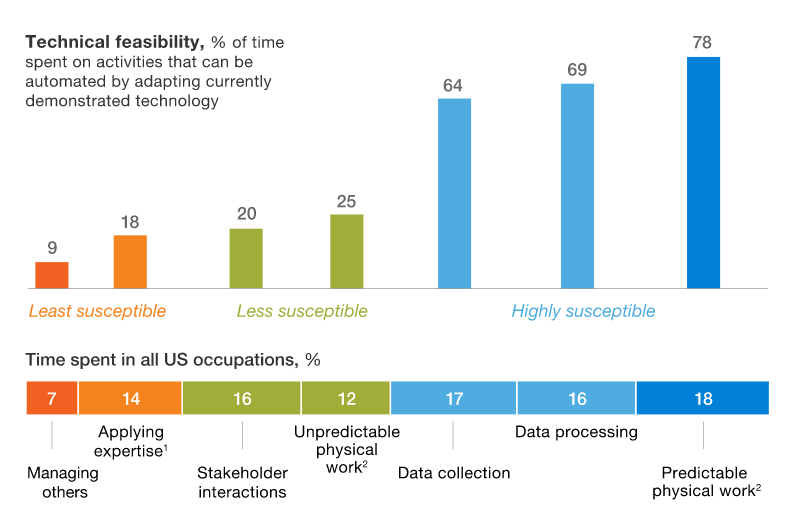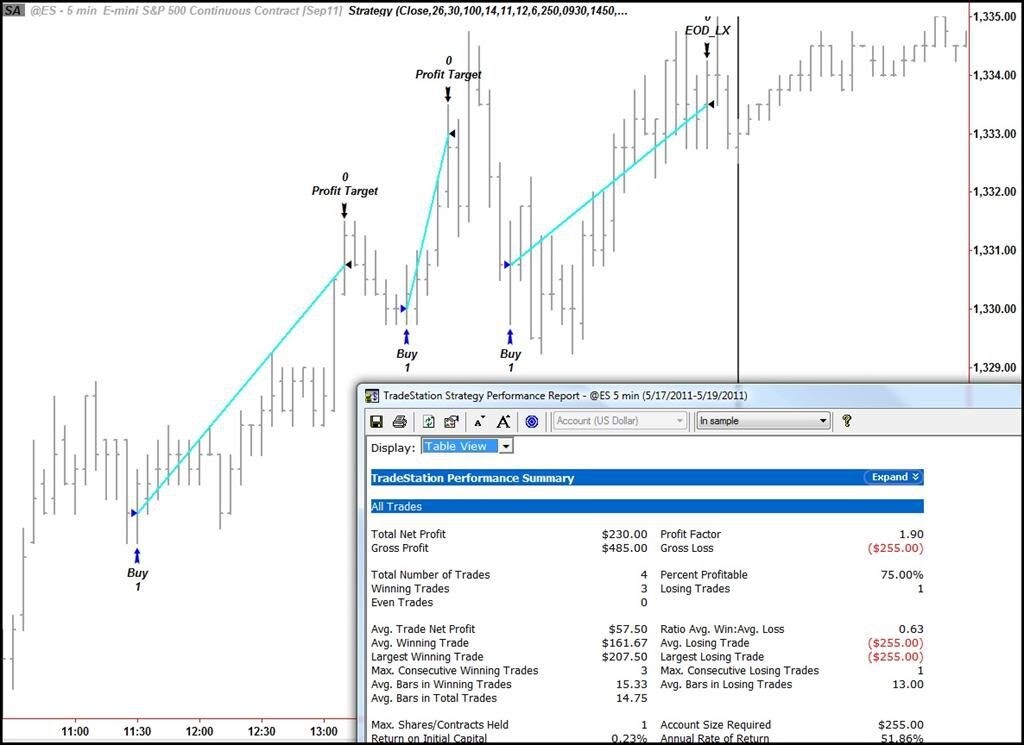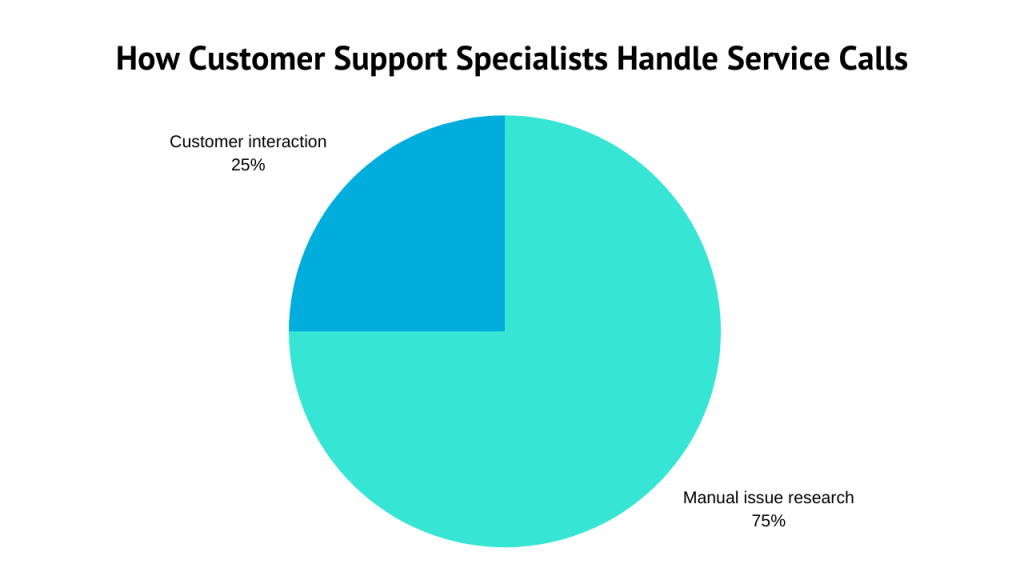We develop software to help people interact with the world as conveniently as possible. One push of a virtual button — a pizza arrives. Click another button — a new game is being installed on your gaming console. The automated process frees you from a lot of hassle.
Where automation truly excels is in accomplishing repetitive and simple tasks. Companies are automating such work to keep expenses low and prevent mistakes. The important question to ask is: Where should we draw the line? Which jobs should be automated, and which are better left to human beings?
Automation Influences Employability
Not all jobs are created equal. When thinking about career prospects and desirable employment opportunities, we tend to prefer jobs in finance, healthcare, tech, entertainment, science, and other intellectually intensive fields.
But there are many jobs where the focus is primarily on attention and physical effort, for example:
- Cleaning services;
- Transportation services;
- Waste collection services.
There are also many labor-intensive and sometimes dangerous jobs that we have yet to make completely safe, for example:
- Coal mining;
- High-rise construction.
These are the kinds of jobs companies are looking to automate. Since they don’t require the same degree of intellectual input, training a machine to do such work is easier, and the repetitive nature of the job also makes it simpler to automate.
Almost all of those jobs theoretically could be automated to some extent. About one-third of constituent activities can be performed by a machine in 60 percent of jobs.
The graph shows how likely certain types of jobs are to be automated.
In US workplaces, one-fifth of overall work time is spent on performing repetitive physical activities in a predictable environment. Workers do the job in a familiar setting where changes are rare or relatively easy to anticipate. It is estimated that around 78% of such activities can be automated.
In manufacturing, workers spend one-third of their time performing physical tasks or operating machinery in a predictable environment. Hindered somewhat by the variable complexity of the manufacturing process, around 59% of such activities can be performed by a machine.
The main advantages of automating such activities are:
- Efficiency. A machine is less prone to making mistakes and can perform the task precisely and on time. After initial installation and setup, a machine may require little to no assistance.
- Cost-effectiveness. Even though automation requires investments during the initial steps, the low maintenance costs are sure to be a huge selling point. Another reason for lower costs is that one machine can often do the work of several employees.
Though automation has room to grow in terms of the tasks it can take on, there are certain types of work that humans are more capable of. Let’s review those tasks.
Core Competency
What You Can’t Automate
We live in a highly competitive world, where knowledge and skill are the prevailing forces. It is essential for a business to offer a unique service or product that sets the company apart. Or that guarantees the best quality and unique expertise in the field of business.
Deep expertise or a unique product are what make you and your business valuable. If it’s possible, in theory, to easily automate the service or production process you offer, it becomes easier to cut you off as the middle-man.
To stay competitive in offering the best service or product, you need to stay on track, perfecting your expertise and knowledge in your field of business.
Let’s take Honda as an example. The company produces many types of motorized devices: cars, motorcycles, lawn mowers, and so on. Those products share the same feature — the high quality of Honda motors, which many companies fail to replicate, despite having higher R&D budgets.
Building fuel-efficient, powerful, and durable engines is the core competency of Honda. It’s the deep expertise of its human engineers that sets the company apart.
What You Can Automate
It’s important when applying technology to ensure that it assists you in reaching your goals, not the other way around.
Honda, while maintaining its core competency — its human expertise — doesn’t shy away from automation in fulfilling its potential.
The company makes strong use of manufacturing execution systems: robots and software do much of the work in building the vehicles their engines go into, improving the bottom line and ensuring safety.
Machines performing vehicle body assembly at Honda without human assistance.
Variable Processes
What You Can’t Automate
Automation is at its best when handling repetitive and simple tasks. But it is more difficult to apply in complex tasks when there are many things that can go wrong. It’s safer to automate a task if variations are easy to predict and it’s possible to identify patterns.
In some cases, variations are chaotic and hard to anticipate, due to the abundance of contributing factors. For example, stock markets are very unpredictable, so it’s hard to apply automation successfully in this field. All it took was one mistake for Knight Capital to lose $1 billion. It’s better to have humans making the most important decisions here.
What You Can Automate
Though stock trading is a highly variable process, it can be automated to some extent. Actually, around 75% of shares are traded with the help of automated trading systems — software that buys and sells stocks if it meets certain pre-established criteria.
An example of an automated trading system.
Applying automation makes sense if you’re looking to:
- Minimize the influence of emotion. The automated system trades only when the trade rules are met. This way, it is impossible for a trader to hesitate about taking action, or to over-trade.
- Strengthen discipline. One of the important rules of stock trading is planning the trade and trading the plan. Due to emotion, let’s say fear of loss, a trader who has had two unsuccessful trades may decide to skip the next one, which could have become beneficial. Automation tools help traders achieve consistency, keep discipline, and follow the trading plan.
- Perform backtesting. Backtesting is a feature that allows traders to test certain rules on historical data before applying them to actual trades. It helps traders come up with precise trading criteria.
- Diversify trading. With automated systems, users can apply different strategies or trade on different accounts at the same time. By doing so, traders can spread risks and protect themselves from losing positions.
Creative Processes
What You Can’t Automate
Creativity is full of chaos, where each decision can be influenced by a huge number of factors. As mentioned above, a machine can have trouble working with unpredictable changes.
Technology is good at defining patterns and acting upon them, while the creative process relies on thinking out of the box.
But there is also Artificial Intelligence, which can work out the rules of any activity, and, in theory, produce art. Experience shows that machines can create from scratch, while humans rely more on past experience.
If you take a look at some examples of AI-generated art, below, it’s obvious that, even when it’s based on artworks created by humans, AI fails to replicate accurate images of human faces and bodies. It fails to build upon human experience.
AI has a hard time replicating human faces and bodies.
In terms of product design or any other creative work that fulfills business needs, the ability to relate to human experience is essential. Creating a product that is comprehensive and easy to use is possible if we rely on user experience.
What You Can Automate
What can be automated are the tools creatives use to work. Let’s take content creation as an example. As we have said, creativity itself is off-limits, but you can improve the process a bit by introducing automation software that can help people perform simple tasks. For instance, on an image or video, automation can be helpful by:
- Automatically removing digital noise;
- Adjusting white balance and color correction;
- Removing items from the shot;
- Enhancing the quality of the footage.
Those are tasks that can be left to a machine powered by Artificial Intelligence. It lets creatives avoid wasting time on technical aspects of the process and focus on creativity.
Google uses Artificial Intelligence to enhance the quality of smartphone pictures.
Emotionally-Charged Tasks
What You Can’t Automate
There are instances where a robot can’t do much to help and human interaction is preferable.
Let’s take customer support as an example. It is good to automate FAQs and user instructions, but if there’s an issue that can’t be solved with basic troubleshooting, the customer would be better off seeking help from a real person. A real person will manage to get into the specifics of a customer’s issue and resolve it successfully.
Customer support specialists spend more of the call time looking for useful information than actually dealing with the issue. Source: IBM.
What You Can Automate
There are also some parts of the process that can use automation:
- Scheduling. A machine can easily handle setting up interviews and offering free time slots.
- Application processes. During the initial stage of the hiring process or any other process that includes gathering information about your customer, applicant, or potential employee, it is usually more convenient for them to fill out the form on a website than talk to a real person. On top of that, the information doesn’t get lost. Details from applications can be presented in a digestible manner, making it easier for managers to process.
- Paperwork. We’re talking invoices, billing, and reports. Automation software can sort out the data while employees do more engaging work.
Deep Collaboration
What You Can’t Automate
Communication can’t be beneficially automated. Though we are advancing in the field of affective computing, it is still a long way from being able to understand and interpret emotion and respond to it properly.
Emotion is a big part of effective human collaboration, along with creative abilities and critical thinking. And those are the features machines lack as of now.
Want to build an automated software solution?
We are ready to leverage our expertise to get things done.
Aleksandra Golik
Head of Sales
at HQSoftware
What You Can Automate
We can use automation tools not to substitute for collaboration, but to enable it. A huge variety of software solutions can help bring people together from different places and time zones to make working easier.
Bottom Line
Automation is a great benefit if applied correctly. Businesses can save money by having machines do repetitive jobs where mistakes can slow down the production process or lead to material losses.
There are also types of jobs and tasks humans simply do better than machines. Trying to automate the following activities can lead to lower efficiency and poor quality of work:
- Company core competency;
- Variable processes;
- Creativity;
- Emotionally charged processes;
- Collaboration.
The reason is simple — humans are better at relating to each other, and these tasks are based on that ability.

HQSoftware Founder
Having founded the company in 2001, uses his broad knowledge to drive the company forward. Ready to share his wisdom on software development and technology insights
Related Posts
View All
We are open to seeing your business needs and determining the best solution. Complete this form, and receive a free personalized proposal from your dedicated manager.

Sergei Vardomatski
Founder












